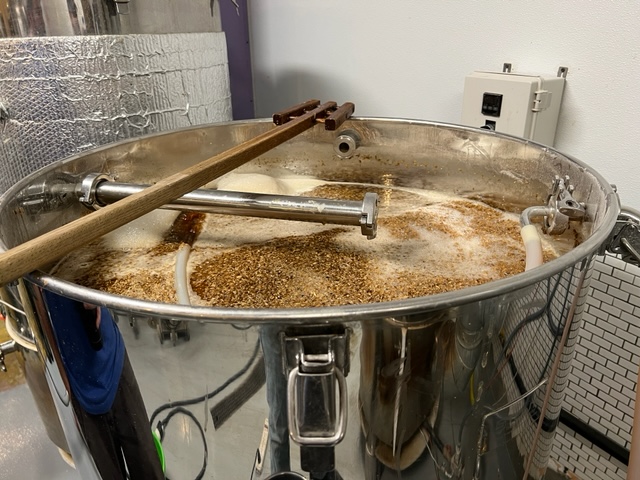A Bonnie Brewday
Like many fields, the brewing industry only prospers with the knowledge of those who have boldly gone before. In the process of navigating regulatory hurdles, finding good suppliers (grain, hops, cleaning products, etc.) and getting answers to “What the Heck Does this Gadget Do?” I have leaned heavily on the excellent input from the local brewing community.
In one of these discussions with my friends over at the Distant Whistle, we began discussing a collaboration batch. The result? Bonnie Star, a Scotch Wee Heavy set to go on tap December, 14th at Distant Whistle Brewhouse (118 S Main St, Vicksburg, MI 49097).

What a beautiful morning! The water was hot and we were ready to start filling up the mash tun. Stirring in the grain as the mash tun fills with water is essential to keep little grain “doughballs” from forming. You want the hot water to completely soak every bit of the malted grains since the water triggers enzymes that will extract those tasty sugars (aka “yeast food”). And besides, stirring the mash paddle is a good workout!

The mash tun is full, time for a quick selfie while Andy works on prepping the wort chiller in the background. I’m already working up a sweat!

Our grains have sat in the hot water bath for about an hour. Now we will give them a rinse with the help of a sparging arm. This will help us ensure we get the most out of the sugar extraction process.

Next we vorlauf before transferring to the boil kettle. Look at that caramelly, rich color! 😋

It takes a while to heat up that much liquid, so in the meantime let’s explore the age-old tradition- shoveling out the mash tun! The spent grain will make a nice treat for some local farm animals. Also, spent grain makes an excellent addition to your favorite bread or pizza dough recipe.

Maillard reactions are super important for a Scotch Wee Heavy so we did an extra long boil in addition to using that quintessential malt of Scotland, Golden Promise. Long boils have the added effect of concentrating the wort (and therefore increasing the alcohol percentage of the final product).
Now we are ready to cool, oxygenate and transfer the wort to the fermenter. Through a well thought out series of pumps and widgets we can achieve this in one seamless transfer process. We also got to play around with a new oxygenation rig, which (to me at least) looks steampunk as heck.

Now we turn to the workhorse of the brewing process, our little- but MIGHTY microbial friends. I am speaking of course about yeast! For this brew, Omega’s OYL-015 Scottish Ale was the perfect fit. Coming from being a homebrewer, this is the most liquid yeast I have ever seen and was a little too excited to pitch it into the fermenter!

You don’t have a to be a Scotsman to enjoy this beer. Make sure to Cross it off your list by getting yourself a Bonnie Star before it’s gone!
Special thanks to Distant Whistle for this amazing opportunity, it was an absolute blast!

